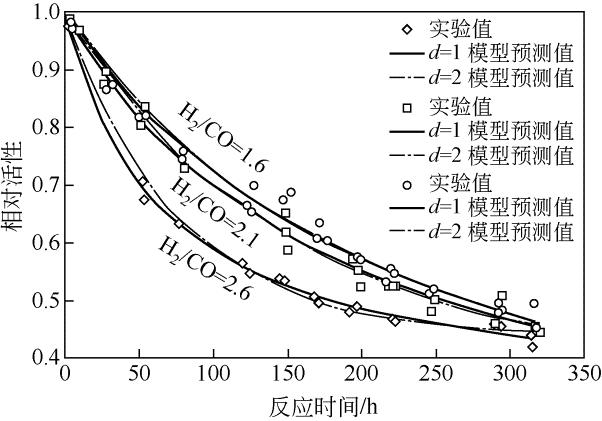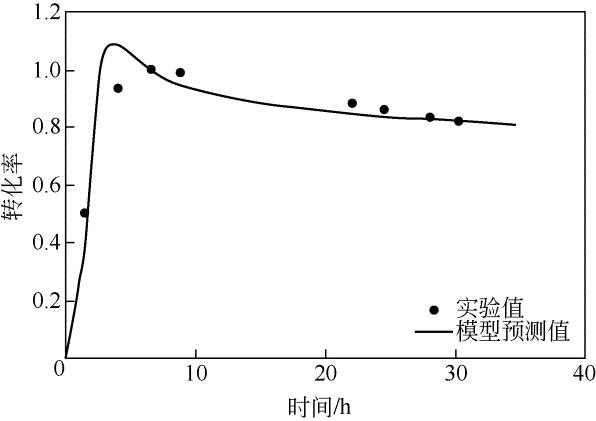| 1 |
田春荣 . 2016年中国石油进出口状况分析[J]. 国际石油经济, 2017, 25(3): 15-25.
|
|
TIAN Chunrong . China’s oil imports and exports in 2016[J]. International Petroleum Economics, 2017, 25(3): 15-25.
|
| 2 |
TAVASOLI A , ABBASLOU R M M , DALAI A K . Deactivation behavior of ruthenium promoted Co/γ-Al2O3 catalysts in Fischer-Tropsch synthesis[J]. Applied Catalysis A: General, 2008, 346: 58-64.
|
| 3 |
ELIASON S A , BARTHOLOMEW C H . Catalyst deactivation[M]. Elsevier Science Publishers B. V., 1991: 211-218.
|
| 4 |
ARGYLE M D , FROST T S , BARTHOLOMEW C H . Cobalt Fischer-Tropsch catalyst deactivation modeled using generalized power law expressions[J]. Topics in Catalysis, 2014, 57: 415-429.
|
| 5 |
ELIASON S A , BARTHOLOMEW C H . Reaction and deactivation kinetics for Fischer-Tropsch synthesis on unpromoted and potassium-promoted iron catalysts[J]. Applied Catalysis A: General, 1999, 186: 229-243.
|
| 6 |
POUR A N , HOUSAINDOKHT M R , TAYYARI S F , et al . Deactivation studies of Fischer-Tropsch synthesis on nano-structured iron catalyst[J]. Journal of Molecular Catalysis A: Chemical, 2010, 330: 112-120.
|
| 7 |
POUR A N , HOSAINI E , FEYZI M . Prediction of cobalt particle size during catalyst deactivation in Fischer-Tropsch synthesis[J]. Journal of the Iranian Chemical Society, 2016, 13: 139-147.
|
| 8 |
ATASHI H , VEISKARAMI S . Determination of the deactivation model of iron-potassium/γ-Al2O3 catalyst in a fixed bed reactor[J]. Physical Chemistry Research, 2018, 6: 365-375.
|
| 9 |
KHORASHADIZADEH M , ATASHI H . Modeling the kinetics of cobalt Fischer-Tropsch catalyst deactivation trends through an innovative modified Weibull distribution[J]. Physical Chemistry Chemical Physics, 2017, 19: 19252-1921.
|
| 10 |
BAE J W, KIM S M, PARK S J , et al . Deactivation by filamentous carbon formation on Co/aluminum phosphate during Fischer-Tropsch synthesis[J]. Industrial Engineering Chemistry Research, 2009, 48(6): 3228-3233.
|
| 11 |
SAIB A M , BORGNA A , LOOSDRECHT J V DE , et al . XANES study of the susceptibility of nano-sized cobalt crystallites to oxidation during realistic Fischer-Tropsch synthesis[J]. Applied Catalysis A: General, 2006, 312: 12-19.
|
| 12 |
KHORASHADIZADEH M , ATASHI H . Toward the development of a robust kinetic model for the cobalt Fischer-Tropsch catalyst lifetime using a novel sigmoidal pattern[J]. Physical Chemistry Research, 2018, 6(1): 173-192.
|
| 13 |
MOODLEY D J , LOOSDRECHT J VAN DE , SAIB A M ,et al Carbon deposition as a deactivation mechanism of cobalt-based Fischer-Tropsch synthesis catalysts under realistic conditons [J].Applied Catalysis A:General,2009,354:102-110.
|
| 14 |
CHO W, YU H , AHN W S, et al . Synthesis gas production process for natural gas conversion over Ni-La2O3 catalyst[J]. Journal of Industrial and Engineering Chemistry, 2015, 28: 229-235.
|
| 15 |
BECHARA R , BALLOY D , VANHOVE D . Catalytic properties of Co/Al2O3 system for hydrocarbon synthesis[J]. Applied Catalysis A: General, 2001, 207: 343-353.
|
| 16 |
LIU Z T , LI Y W , ZHOU J L , et al . Deactivation model of Fischer-Tropsch synthesis over an Fe-Cu-K commercial catalyst[J]. Applied Catalysis A: General, 1997, 161: 137-151.
|
| 17 |
SADEQZADEH M , CHAMBREY S , HONG J P , et al . Effect of different reaction conditions on the deactivation of alumina-supported cobalt Fischer-Tropsch catalysts in a milli-fixed-bed reactor: experiments and modeling[J]. Industrial Engineering Chemistry Research, 2014, 53: 6913-6922.
|
| 18 |
YATES I C , SATTERFIELD C N . Intrinsic kinetics of the Fischer-Tropsch synthesis on a cobalt catalyst[J]. Energy Fuels, 1991, 5(1): 168-173.
|
| 19 |
SADEQZADEH M , HONG J P , FONGARLAND P , et al . Mechanistic modeling of cobalt based catalyst sintering in a fixed bed reactor under different conditions of Fischer-Tropsch synthesis[J]. Industrial Engineering Chemistry Research, 2012, 51(27): 11955-11964.
|



